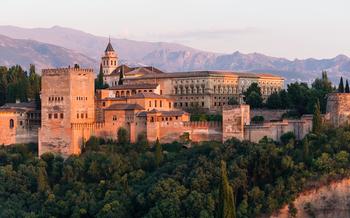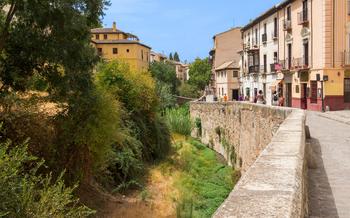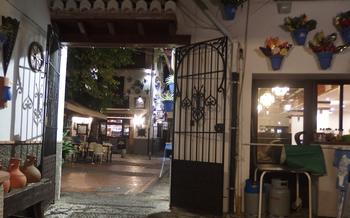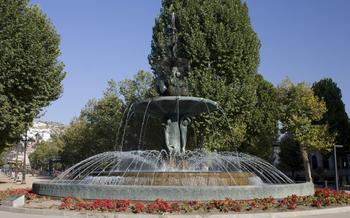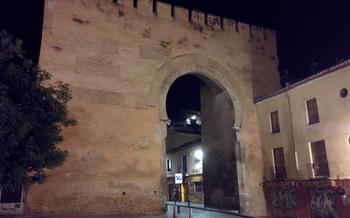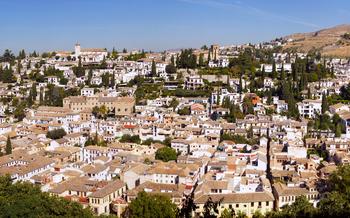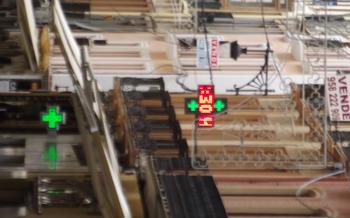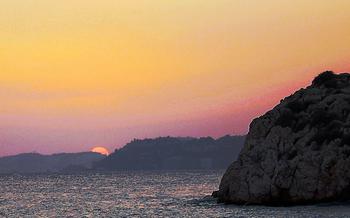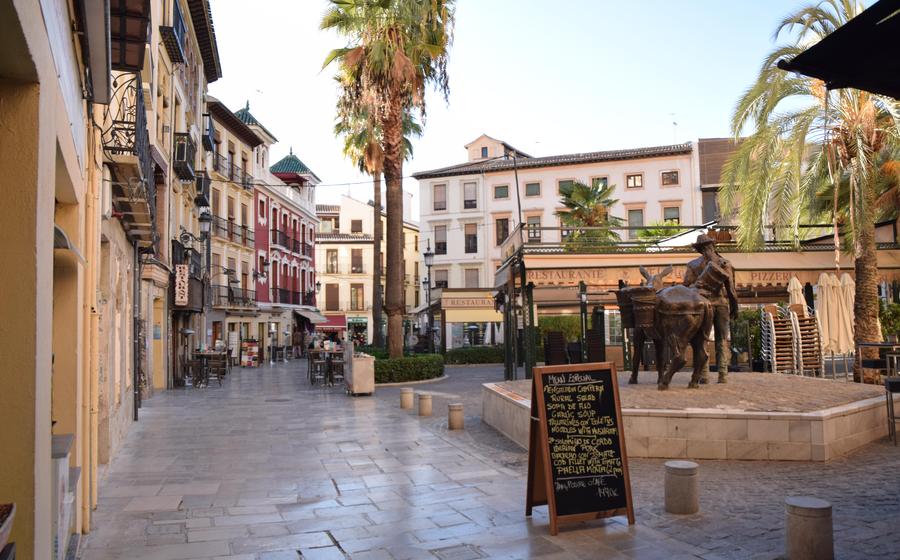
Plaza de la Romanilla
- Plaza de la Romanilla: A Symbol of Granada's History
- The Roman Amphitheater: A Legacy of Roman Rule
- Architectural Features and Design
- Archaeological Excavations and Discoveries
- Ongoing Conservation Efforts
- The Arab Baths: A Glimpse into Granada's Islamic Heritage
- Casa del Chapiz: A Palace of Beauty and Harmony
- History and Ownership
- Architectural Style and Design Elements
- Interior Features and Decorations
- Current Use as a Cultural Center
- Calle Calderería Vieja: A Shopping Haven in the Heart of Granada
- Calle Elvira: A Vibrant Street with a Rich History
- Alhambra: A Majestic Palace and UNESCO World Heritage Site
- Sacromonte Abbey: A Spiritual Retreat in Cave Dwellings
- Flamenco Show: A Cultural Experience in Granada
- Local Cuisine: Tantalizing Flavors of Granada
- Insider Tip: Explore the Albaicín Neighborhood
Plaza de la Romanilla: A Symbol of Granada's History
The Plaza de la Romanilla is a charming square in the heart of Granada, Spain, that holds a wealth of historical and cultural significance. It serves as a vibrant gathering place for locals and tourists alike, offering a glimpse into the city's rich past. The plaza's cobblestone streets and picturesque surroundings create a unique atmosphere that transports visitors back in time.
The plaza's historical roots can be traced back to the Roman period, when it was the site of a thriving marketplace. Later, during the Arab rule of Granada, it became a bustling center of commerce and social interaction. The square's name, Romanilla, is believed to derive from the Arabic term "Rahmaniyya," which refers to a place of public gatherings.
Architecturally, the Plaza de la Romanilla showcases a blend of Roman and Arab influences. The square is surrounded by historic buildings, many of which feature intricate facades and decorative elements. The most notable structure is the Roman Amphitheater, an ancient relic that stands as a testament to Granada's Roman heritage.
Throughout history, the Plaza de la Romanilla has served as a vital meeting point for the people of Granada. It has hosted numerous cultural events, festivals, and celebrations, reflecting the city's vibrant cultural traditions. Today, the square continues to be a popular spot for locals to socialize, relax, and enjoy the lively atmosphere.
The Roman Amphitheater: A Legacy of Roman Rule
The Roman Amphitheater, situated in the heart of Granada's Plaza de la Romanilla, stands as a testament to the city's rich and diverse history. Constructed during the 1st century AD, this ancient arena served as a venue for gladiatorial contests and other public spectacles, offering a glimpse into the grandeur and brutality of Roman rule.
Architectural Features and Design
The amphitheater's elliptical shape, typical of Roman amphitheaters, reflects the architectural ingenuity of the era. Its imposing structure, built using local stone, features tiers of seating that once accommodated thousands of spectators. The arena floor, where gladiators and wild animals fought, is still visible, providing a tangible connection to the past.
Archaeological Excavations and Discoveries
Extensive archaeological excavations conducted in the area have unearthed a wealth of artifacts, shedding light on the amphitheater's history and significance. These excavations have revealed intricate mosaics, sculptures, and inscriptions, offering valuable insights into the daily life and entertainment of Roman Granada.
Ongoing Conservation Efforts
Recognizing the importance of this historical landmark, significant efforts have been made to preserve and restore the Roman Amphitheater. Restoration projects aim to protect and enhance the amphitheater's structural integrity, ensuring its preservation for future generations to appreciate.
The Arab Baths: A Glimpse into Granada's Islamic Heritage
The Arab Baths, also known as the Bañuelo, offer a fascinating glimpse into Granada's rich Islamic heritage. Built in the 11th century, these baths were an integral part of the city's daily life and served as a place for both physical and spiritual cleansing.
The baths feature a unique layout, consisting of three main chambers: the cold room, the warm room, and the hot room. Each chamber is adorned with intricate carvings, arches, and ceramic tiles, reflecting the artistic prowess of the Islamic artisans. The warm and hot rooms were equipped with underfloor heating, creating a comfortable environment for bathers.
The Arab Baths are connected to the nearby Palacio de los Tiros, a former palace that now houses the Archaeological Museum of Granada. This connection highlights the close relationship between the baths and the ruling elite of the city.
Today, the Arab Baths have been meticulously restored and preserved, offering visitors a chance to step back in time and experience an essential part of Granada's Islamic legacy. They are a testament to the city's diverse cultural heritage and continue to inspire awe and wonder in visitors from around the world.
Casa del Chapiz: A Palace of Beauty and Harmony
Standing gracefully in the heart of Granada, Casa del Chapiz, also known as the Palacio del Chapiz, is a captivating architectural gem that embodies the city's rich history and cultural heritage. Built in the 15th century during the Nasrid dynasty, the palace served as a summer residence for the ruling sultans and their families. Its name, Chapiz, derives from the Arabic word "shabbaz," meaning "window," alluding to the palace's prominent windows that offer breathtaking views of the surrounding landscape.
History and Ownership
The Casa del Chapiz has witnessed a remarkable journey throughout the centuries, passing through various hands and undergoing several transformations. Originally constructed by Sultan Muhammad VII, the palace was later expanded and embellished by subsequent Nasrid rulers. After the Reconquista, it was confiscated by the Catholic Monarchs and became a property of the Mendoza family, who introduced significant modifications to adapt it to their tastes and needs.
Architectural Style and Design Elements
The Casa del Chapiz showcases a harmonious blend of Islamic and Renaissance architectural styles, reflecting Granada's unique position as a crossroads of cultures. Its exterior facade features a combination of brickwork and stone, adorned with intricate carvings and decorative elements that pay homage to both traditions. The interior of the palace is equally captivating, with its exquisite plasterwork, colorful tilework, and graceful horseshoe arches. Courtyards, fountains, and gardens create a tranquil ambiance, inviting visitors to immerse themselves in the serenity and beauty of the surroundings.
Interior Features and Decorations
The Casa del Chapiz boasts an array of captivating features that showcase the opulence and artistry of its past occupants. The Hall of the Lions, with its stunning vaulted ceiling adorned with intricate stuccowork, is a testament to the palace's grandeur. The Hall of the Kings, with its vibrant tilework and a fountain surrounded by a colonnade, exudes a sense of regal elegance. The palace also features several bedrooms, each decorated with unique designs and colorful tiles, offering a glimpse into the private lives of its former inhabitants.
Current Use as a Cultural Center
Today, the Casa del Chapiz serves as a vibrant cultural center, hosting a variety of events, exhibitions, and educational programs. Visitors can explore the palace's beautifully preserved rooms, admire its architectural details, and learn about its rich history. The center also offers workshops, concerts, and other cultural activities, allowing visitors to delve deeper into Granada's cultural heritage and traditions.
Calle Calderería Vieja: A Shopping Haven in the Heart of Granada
Calle Calderería Vieja is a vibrant shopping street located in the heart of the historic Albaicín neighborhood. Its name, which means "Street of the Old Coppersmiths," hints at its past as a center for metalworking. Today, the street is lined with a diverse array of shops and boutiques, offering a delightful mix of traditional crafts, souvenirs, and modern fashion.
One of the highlights of Calle Calderería Vieja is its abundance of traditional crafts shops. Here, visitors can find a wide range of handmade items, including intricate pottery, colorful textiles, and delicate filigree jewelry. These shops are a great place to pick up unique souvenirs and gifts that reflect the rich cultural heritage of Granada.
In addition to traditional crafts, Calle Calderería Vieja also offers a variety of modern fashion boutiques. These shops cater to a younger crowd, with trendy clothing, accessories, and footwear. Whether you're looking for a new outfit or just browsing for inspiration, you're sure to find something to your liking along this vibrant street.
As you stroll along Calle Calderería Vieja, be sure to take in the lively atmosphere. Street performers often entertain passersby with music, dance, or acrobatics, adding to the vibrant energy of the street. With its eclectic mix of shops, traditional crafts, and lively atmosphere, Calle Calderería Vieja is a must-visit destination for anyone exploring the heart of Granada.
Calle Elvira: A Vibrant Street with a Rich History
Calle Elvira is one of the most vibrant and historic streets in Granada, Spain. Located in the heart of the city, it has been a witness to centuries of history and cultural exchange. The street takes its name from Elvira, a Visigothic princess who was said to have been kidnapped and taken to North Africa by Muslim raiders in the 8th century.
Calle Elvira was once part of the main road that connected Granada to the Mediterranean coast. As a result, it became a melting pot of cultures and a hub of trade and commerce. The street is lined with shops, restaurants, and bars, many of which have been in operation for generations.
Calle Elvira is also home to several cultural attractions, including the Casa del Chapiz, a 16th-century palace that is now a museum, and the Palacio de los Tiros, a 14th-century palace that is now home to the city's historical archive.
The street is particularly lively in the evenings, when locals and tourists alike spill out of the bars and restaurants to enjoy the warm summer air. Street performers often entertain the crowds with music, dance, and acrobatics, creating a vibrant and festive atmosphere.
Whether you're looking to shop, eat, drink, or simply soak up the atmosphere, Calle Elvira is a must-visit destination in Granada.
Alhambra: A Majestic Palace and UNESCO World Heritage Site
Rising majestically above Granada, the Alhambra Palace stands as a testament to the grandeur of the Nasrid dynasty. This UNESCO World Heritage Site is an architectural marvel, blending Islamic, Christian, and Renaissance elements into a breathtaking ensemble. Its intricate carvings, vibrant tiles, and lush gardens transport visitors to a time of opulence and artistry.
The Alhambra's history is as rich as its architecture. Originally a small fortress in the 9th century, it was transformed into a royal palace in the 13th century and served as the seat of the Nasrid rulers for over 250 years. After the Reconquista, the Alhambra underwent significant renovations under Christian rule, adding Renaissance elements to its Islamic foundation.
Must-see attractions within the Alhambra include the Nasrid Palaces, with their intricate muqarnas ceilings and stunning views of the city; the Court of the Lions, with its iconic fountain surrounded by delicate columns; and the Generalife Gardens, an oasis of tranquility with its serene pools, fragrant flowers, and cypress trees.
A visit to the Alhambra is a journey through time, where the echoes of history mingle with the beauty of art and architecture. It's a place where the past comes alive, inviting visitors to immerse themselves in the splendor of a bygone era.
Sacromonte Abbey: A Spiritual Retreat in Cave Dwellings
Nestled in the Sacromonte hills, overlooking the breathtaking panorama of Granada, the Sacromonte Abbey is a unique and enchanting site. This former monastery, dating back to the 16th century, is renowned for its extraordinary cave dwellings, carved into the soft rock by hermitic monks seeking spiritual solitude and communion with nature.
The Sacromonte Abbey holds a deep spiritual and cultural significance, particularly for the Roma (Gypsy) community of Granada. They have traditionally inhabited the caves and played a pivotal role in preserving the abbey's legacy. The caves, some of which are open to visitors, offer a glimpse into the simple and austere lifestyle of these hermits, who sought spiritual enlightenment in the seclusion of the caves.
Beyond its spiritual significance, the Sacromonte Abbey is also a cultural hub, hosting flamenco performances and other cultural events that celebrate the rich heritage of Granada. Visitors can immerse themselves in the vibrant and passionate rhythms of flamenco, a UNESCO-recognized Intangible Cultural Heritage of Humanity, and experience the raw emotions expressed through dance, music, and song.
Whether seeking spiritual reflection, cultural immersion, or simply marveling at the architectural ingenuity of the cave dwellings, the Sacromonte Abbey is a must-visit destination for anyone exploring Granada.
Flamenco Show: A Cultural Experience in Granada
Flamenco, a captivating art form that blends dance, music, and song, is deeply rooted in the cultural heritage of Granada. Its origins can be traced back to the region of Andalusia, where it emerged as a fusion of different cultures, including Gypsy, Moorish, and Jewish influences.
In Granada, flamenco has flourished over the centuries, becoming an integral part of the city's identity. The city boasts numerous tablaos (flamenco venues) where visitors can immerse themselves in this vibrant and passionate art form.
Flamenco performances typically feature a group of dancers, singers, and guitarists who come together to create a captivating spectacle. The dancers, adorned in colorful trajes de flamenca (flamenco dresses), showcase their intricate footwork and expressive body movements, while the singers deliver soulful vocals that capture the essence of flamenco.
The guitarists provide the rhythmic foundation for the performance, creating a mesmerizing interplay of sound and movement. Each element of flamenco, from the intricate footwork to the passionate singing, contributes to a captivating experience that leaves audiences spellbound.
Attending a flamenco show in Granada is a must-do for anyone seeking an authentic cultural experience. Whether you're a seasoned flamenco aficionado or a first-time visitor, the city's tablaos offer an unforgettable immersion into the world of this captivating art form.
Local Cuisine: Tantalizing Flavors of Granada
Indulge in the culinary delights of Granada, where traditional dishes burst with flavor and showcase the region's rich cultural heritage. Savor the iconic Habas con Jamón, a simple yet satisfying dish of stewed fava beans with cured ham, embodying the essence of rustic Granadian cuisine. Remojón Granadino, a refreshing salad featuring oranges, cod, and olives, offers a unique blend of flavors and textures. Don't miss the Tortilla del Sacromonte, a unique omelet made with brains, potatoes, and spices, a testament to the city's culinary creativity.
For a taste of local tapas, try Berenjenas con Miel, fried eggplant drizzled with honey, or Salmorejo, a chilled tomato soup similar to gazpacho, but thicker and creamier. Papas a lo Pobre, a humble dish of fried potatoes, eggs, and peppers, is a beloved local favorite. And of course, no visit to Granada is complete without sampling the Churros con Chocolate, crispy fried dough served with thick, hot chocolate, a perfect sweet treat to end your culinary journey.
Insider Tip: Explore the Albaicín Neighborhood
Venture into the heart of Granada's history by exploring the Albaicín neighborhood, a UNESCO World Heritage Site. Lose yourself in its labyrinthine streets, adorned with whitewashed houses and vibrant street art. Discover hidden plazas, charming shops, and traditional tapas bars. Climb to the Mirador de San Nicolás for breathtaking views of the Alhambra and the Sierra Nevada mountains. Along your journey, uncover the rich heritage of the neighborhood, once home to diverse cultures and civilizations. Embrace the vibrant atmosphere, indulge in local delicacies, and immerse yourself in the authentic essence of Granada.

